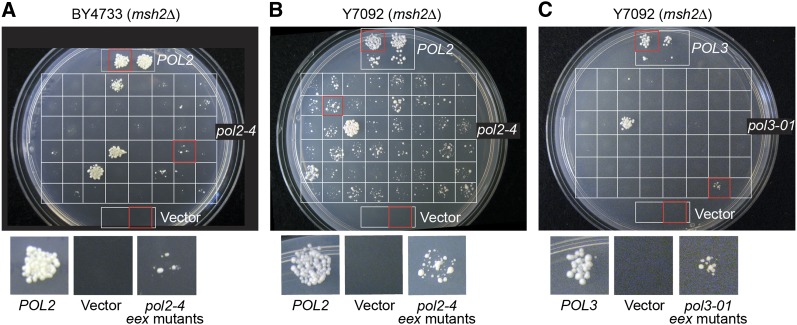Figure 3.
Escape from error-induced extinction. (A and B) Plasmid shuffling was used to screen for eex mutants that suppress pol2-4 msh2Δ synthetic lethality. pol2Δ msh2Δ POL2–URA3 strains derived from (A) BY4733 and (B) Y7092 were transformed with pol2-4, POL2, or vector-only LEU2 plasmids. Approximately 104–105 cells from 48 independent pol2-4 transformants of each strain were spotted separately in a 6 × 8 grid on FOA-containing media to select for loss of the POL2–URA3 plasmid and to isolate suppressor mutants. Bona fide suppressors containing pol2-4 as the sole source of Pol ε arose at a rate of 1.9 × 10−4 eex mutants/cell division in the BY4733 strain [95% confidence interval (C.I.) = 2.6 × 10−4 – 1.3 × 10−4] and 4.0 × 10−3 in the Y7092 background (95% CI = 4.4 × 10−3 – 3.6 × 10−3). (C) A similar plasmid-shuffling strategy was used to estimate the rate of escape from pol3-01 msh2Δ synthetic lethality in the Y7092 background (8.8 × 10−6 eex mutants/cell division; 95% CI = 2.0 × 10−5 – 1.6 × 10−6). In C, 10-fold fewer viable cells were plated in each grid position compared to A and B. The POL2 control patches in A are two independent transformants. The POL2 and POL3 control patches in B and C are also from replicate transformants and include 10-fold dilutions of each. Rates (eex mutants/cell division) were calculated as described in Materials and Methods. Red boxes indicate grid positions magnified below each plate.

